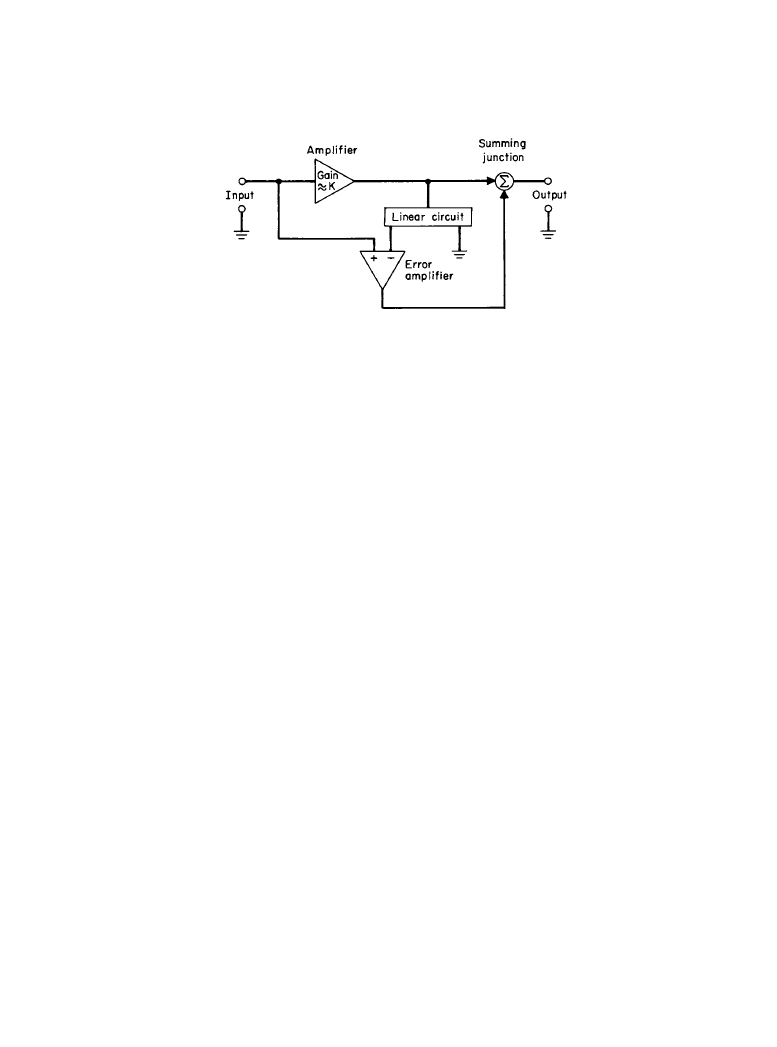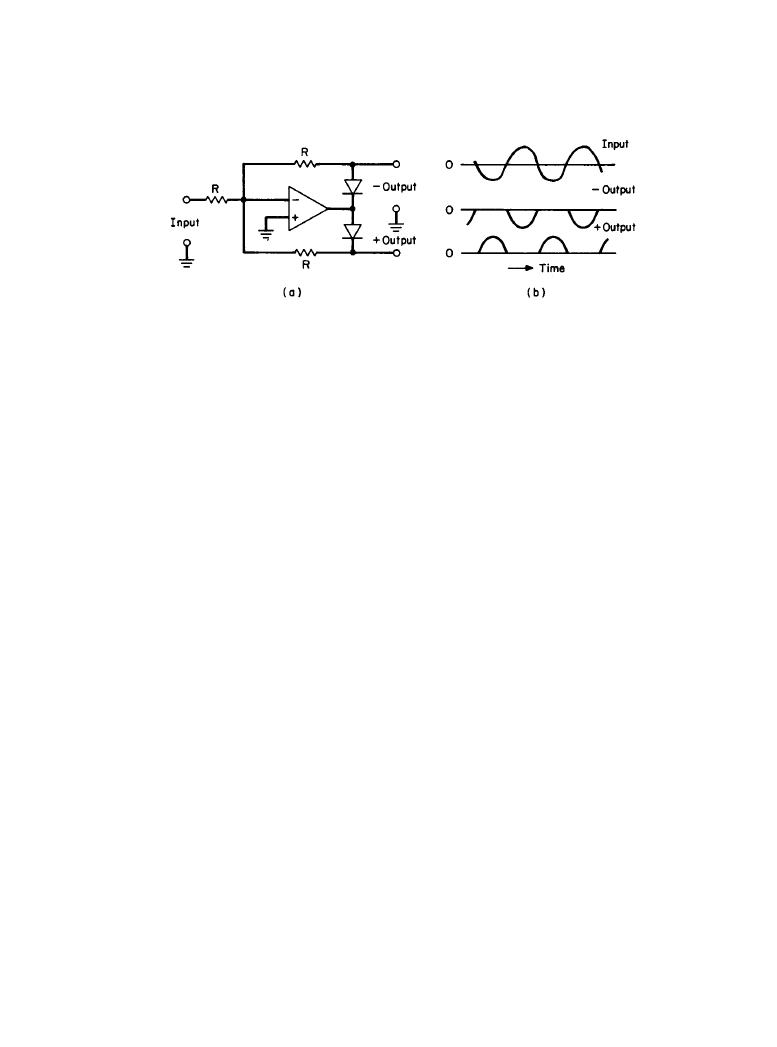ВУЗ: Казахская Национальная Академия Искусств им. Т. Жургенова
Категория: Книга
Дисциплина: Не указана
Добавлен: 03.02.2019
Просмотров: 21657
Скачиваний: 19

Low Power Amplifiers 4-65
Feed Forward
Feedback is a method of correcting amplifier errors after they have occurred and have been com-
pared with the input signal (Figure 4.3.17). One feed-forward method is to measure the errors
that an amplifier will introduce into the output signal and then to feed these errors, inverted in
phase, directly to the output summing junction through a separate path, which may also include
an amplifier of lesser output range, since only the error signal will have to be supplied. A portion
of the resulting output signal may also be fed back for further error correction.
In feed-forward circuits, the error signal is handled by an amplifier, separate from the ampli-
fier whose errors need correcting. In feedback circuits, the error signal is handled by the ampli-
fier causing the errors.
Nonlinear Feedback
Precision rectifier circuits make use of nonlinear feedback. Here, one or more diodes in the feed-
back loop of an operational amplifier result in an output signal which is the half-wave or full-
wave rectified signal originally present at the input of the circuit (Figure 4.3.18). Rectification of
signals is a function needed in signal-processing circuits, such as compressors, expanders,
meters, and noise reduction circuits for pulse or random noise.
Voltage Feedback
The output voltage of an amplifier, attenuated in a voltage-divider network, is subtracted from
the input voltage, resulting in the amplifier input voltage with feedback. The gain reduction ratio
is equal to the reduction ratio of the output impedance of the amplifier, equal to the distortion
reduction ratio for signals of the same output voltage, and inversely proportional to the input
impedance increase ratio of the amplifier. When the loop gain of the amplifier is very high, as is
normal in operational amplifiers, the voltage gain of the amplifier with feedback is nearly equal
to the inverse of the loss of the feedback attenuator, and the output impedance of the amplifier
becomes very low. Therefore, any variation in amplifier load will have little effect on output volt-
age until the maximum output-current capability of the amplifier is reached.
In an alternate circuit, the amplifier need not add signal and feedback voltages because only
one input terminal is required. Here, the output voltage is converted to a current using an imped-
Figure 4.3.17
Feed-forward amplifier phase or gain error correction by negative feedback.
Downloaded from Digital Engineering Library @ McGraw-Hill (www.digitalengineeringlibrary.com)
Copyright © 2004 The McGraw-Hill Companies. All rights reserved.
Any use is subject to the Terms of Use as given at the website.
Low Power Amplifiers

4-66 Microphone Devices and Systems
ance and fed to the input terminal, which also receives input current from the signal source, per-
haps through a second impedance. The amplifier now amplifies the difference between the two
currents. Output impedance and distortion are affected similarly.
Voltage feedback causes the amplifier to become a nearly constant voltage source with a
fixed input signal [10].
Current Feedback
The output current of an amplifier may conveniently be converted to a voltage by passing this
current through an impedance connected in series with the load impedance. The resulting volt-
age is then applied as a feedback voltage to the amplifier. With such a circuit, the internal output
impedance ratio of the amplifier will be equal to the inverse of the current gain reduction ratio
achieved, and the distortion reduction ratio will be the same as the output-current reduction ratio
for the same input signal. Again, the feedback signal may be a feedback voltage, with the ampli-
fier utilizing the difference in feedback and signal voltages, or a feedback current, with the
amplifier supplying current gain.
Current feedback causes the amplifier to become a nearly constant current source with a
fixed input signal.
4.3.4b
Output and Input Impedance
The output impedance of an amplifier usually varies with frequency and is mostly resistive for an
amplifier that has a constant fraction of the output fed back to the input or an intermediate stage.
The output impedance is sometimes expressed as the damping factor of the amplifier, defined as
the ratio of nominal load resistance to amplifier internal output impedance. The value of output
impedance also includes any impedances connected between the output wiring terminals and the
actual output and ground nodes of the circuit.
Another measure of output impedance of an amplifier is regulation, usually measured in per-
centages and defined as the change in output voltage as the nominal load is changed from open-
circuit to rated load. Damping factor and regulation are normally rated at mid-frequencies. At the
extremes of the frequency range, the output impedance of an amplifier will be different from its
midfrequency value because the loop gain of an amplifier decreases, particularly at high frequen-
Figure 4.3.18
Nonlinear precision-rectifier feedback: (
a) operational amplifier circuit, (b) sine-wave
input-output waveforms.
Downloaded from Digital Engineering Library @ McGraw-Hill (www.digitalengineeringlibrary.com)
Copyright © 2004 The McGraw-Hill Companies. All rights reserved.
Any use is subject to the Terms of Use as given at the website.
Low Power Amplifiers

Low Power Amplifiers 4-67
cies. The output impedance of an amplifier can then be described as a two-terminal network of
resistors and reactive elements.
Input impedance of an amplifier may often be set by a physical resistor connected across the
input terminals that shunts the input impedance of the circuit. An additional component of the
input impedance sometimes rated is the input capacitance, partially composed of the wiring
capacitance and any capacitors which are part of the radio-frequency filters of the input circuit or
are capacitors designed to give the desired termination to certain source signals. In low-noise
amplifiers, the input resistance component will be largely determined by feedback to the input
circuit.
When a number of amplifiers and other circuits are connected in series so that each amplifier
amplifies the output signal from the previous circuit, the connections are often made on a voltage
basis, in which each amplifier has a relatively high input impedance and a relatively low output
impedance. Here, the amplifier takes very little of the load current that could be provided by the
circuit at its input, and its own output voltage changes very little, whether supplying full-load
current or not. This type of design is used most often in self-contained equipment or in pieces of
equipment operated in close proximity to each other.
Equipment used as part of large distributed systems or with program transmission lines is
often designed to present a constant output impedance and input impedance to match the nomi-
nal impedance of transmission lines. Audio line impedances of 150 or 600
Ω are common values.
At video and radio frequencies, transmission-line impedances of 50, 75, and 300
Ω are preferred.
Equipment designed to operate in constant-impedance circuits is often rated in decibels with
respect to 1 mW (dBm) of output power into a matched load. Gain or loss are given in decibels,
and systems are designed on a power gain or loss basis. The advantage of operating circuits at
matched transmission-line impedances is that reflections or echoes of signals will not be gener-
ated at the receiving end of a traveling signal.
4.3.4c
Feed Forward and Correction of Estimated Errors
Some error correction can be accomplished by making a good estimate of the error and then pre-
distorting the signal with opposing distortion. This model may contain amplitude or phase non-
linearities, or both. Such correction can be quite complex and requires considerable accuracy in
modeling of distortion components.
4.3.4d
Differential Amplifier
Amplifiers that allow the measurement or use of signals generated remote from the point of
equipment location are called instrumentation amplifiers. These amplifiers have controlled
amplification for the difference in voltage between two signals and very low amplification for
the sum of the two signals, the measurement of the voltages made with the local ground refer-
ence. In general terms, these amplifiers have a controlled differential- or transverse-mode gain
and a low common- or longitudinal-mode gain. The common instrumentation amplifier connec-
tion uses three operational amplifiers, with the first two circuits amplifying the two signals
equally and sharing a common feedback resistor R
1
between the two negative inputs. The output
signals then pass through two identical resistor attenuators R
3
and R
4
, with the resistor junctions
connected to the positive and negative inputs of the third amplifier and resistor R
4
completing the
connection between positive input and ground and negative input and output. A simplified-ver-
Downloaded from Digital Engineering Library @ McGraw-Hill (www.digitalengineeringlibrary.com)
Copyright © 2004 The McGraw-Hill Companies. All rights reserved.
Any use is subject to the Terms of Use as given at the website.
Low Power Amplifiers

4-68 Microphone Devices and Systems
sion instrumentation amplifier omits the two input stages and connects signal wires directly to
the two resistor networks, which now present unequal loads to the two signal wires.
The performance of a differential or instrumentation amplifier is measured by its common-
mode rejection, which is the ratio of differential- to common-mode gain. This value is largely
determined by the accuracy of resistor matching and the ratio of amplifier loop gain to circuit
gain. Common signals must not exceed the maximum allowable common-mode input signal for
the amplifier.
Differential amplifiers are used in audio, video, and computer equipment when signal sources
are widely separated or when ground-loop signals may exist. The two input-signal leads of a dif-
ferential amplifier are brought directly to the source of signals, often as a pair of twisted wires
4.3.5
References
1.
Shockley, W: “The Theory of P-N Junctions in Semiconductors and P-N Junction Transis-
tors,” Proc. JRE, vol. 41, June 1953.
2.
Shockley, W: “A Unipolar Field-Effect Transistor,” Proc. IRE, vol. 40, November 1952.
3.
Kirchner, R. J.: “Properties of Junction Transistors,” Trans. IRE PGA, AU-3(4), July-
August 1955.
4.
Trent, R. L.: “Design Principles for Transistor Audio Amplifiers,” Trans. IRE PGA, AU-
3(5), September–October 1955.
5.
Garner, L. H.: “High-Power Solid State Amplifiers,” Trans. IRE PGA, 15(4), December
1967.
6.
Fewer, D. R.: “Design Principles for Junction Transistor Audio Power Amplifiers,” Trans.
IRE PGA, AU-3(6), November–December 1955.
7.
Petersen, A., and D. B. Sinclair: “A Singled-Ended Push-Pull Audio Amplifier,” Proc. IRE,
vol. 40, January 1952.
8.
Widlar, R. J.: “A Unique Current Design for a High Performance Operational Amplifier
Especially Suited to Monolithic Construction,” Proc. NEC, 1965.
9.
Black, H. S.: U.S. Patent 2,102,671.
10.
Walker, P. J.: “A Current Dumping Audio Power Amplifier,” Wireless World, December
1975.
4.3.6
Bibliography
Harper, C. A. (ed.): Handbook of Components for Electronics, McGraw-Hill, New York, N.Y.,
1977.
Lynn, D. K., C. S. Meyer, and D. C. Hamilton (eds.): Analysis and Design of Integrated Circuits,
McGraw-Hill, New York, N.Y., 1967.
Weinberg, L.: Network Analysis and Synthesis, McGraw-Hill, New York, N.Y., 1967.
Downloaded from Digital Engineering Library @ McGraw-Hill (www.digitalengineeringlibrary.com)
Copyright © 2004 The McGraw-Hill Companies. All rights reserved.
Any use is subject to the Terms of Use as given at the website.
Low Power Amplifiers

5-1
Section
5
Sound Reproduction Devices and
Systems
One of the problems with selecting a high-quality monitor system lies in the difficulty of defin-
ing quality. Some not-too-scientific descriptions may develop from discussions with other users,
and even with knowledgeable authorities. Terms such as “solid bass,” “smooth highs,” “tight,” or
“clean” all may be mentioned as monitor system requirements. Trying to incorporate these sub-
jective requirements into a working system is almost impossible. On the other hand, selecting a
speaker solely on the basis of frequency response and harmonic distortion is likewise inappropri-
ate. It is difficult to equate either scientific measurements or subjective considerations with how
“good” or “bad” a particular speaker system sounds.
For the purposes of this examination, the term speaker will refer to a single transducer. Mon-
itor or monitor system will refer to an assembly of speaker(s), enclosures and, where appropriate,
crossovers and amplifiers. In fact, it might be best to consider a monitor system as having at least
three major components: source driver (amplifier), transducer (speaker) and mounting assembly
(cabinet).
A speaker cannot produce acoustic energy without being driven by an electronic source. It
likewise requires an enclosure to properly couple acoustic energy into the listening environment
in a controlled manner. Even the most expensive speaker, if set on a shelf without an appropriate
enclosure, will perform poorly.
In This Section:
Chapter 5.1: Electroacoustic Transducers
5-5
Introduction
5-5
Basic Equations and Features of Dynamic Transducers
5-5
Basic Equations and Features of Electromagnetic Transducers
5-7
Basic Equations and Features of Electrostatic Transducers
5-9
Basic Equations and Features of Piezoelectric Transducers
5-11
Control System and Its Acoustic Characteristics
5-14
Bibliography
5-15
Downloaded from Digital Engineering Library @ McGraw-Hill (www.digitalengineeringlibrary.com)
Copyright © 2004 The McGraw-Hill Companies. All rights reserved.
Any use is subject to the Terms of Use as given at the website.
Source: Standard Handbook of Audio and Radio Engineering